Mlyniv
Mlyniv (Ukrainian: Млинів; Polish: Młynów) is an urban-type settlement in Rivne Oblast (province) in western Ukraine. Mlyniv is also the administrative center of Mlyniv Raion (district), housing the district's local administration buildings. Its population was 8,446 as of the 2001 Ukrainian Census.[2] Current population: 8,205 (2020 est.)[3]
Mlyniv
Млинів | |
|---|---|
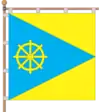 Flag  Coat of arms | |
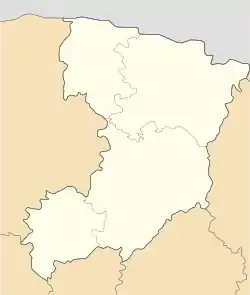 Mlyniv Location of Mlyniv in Ukraine 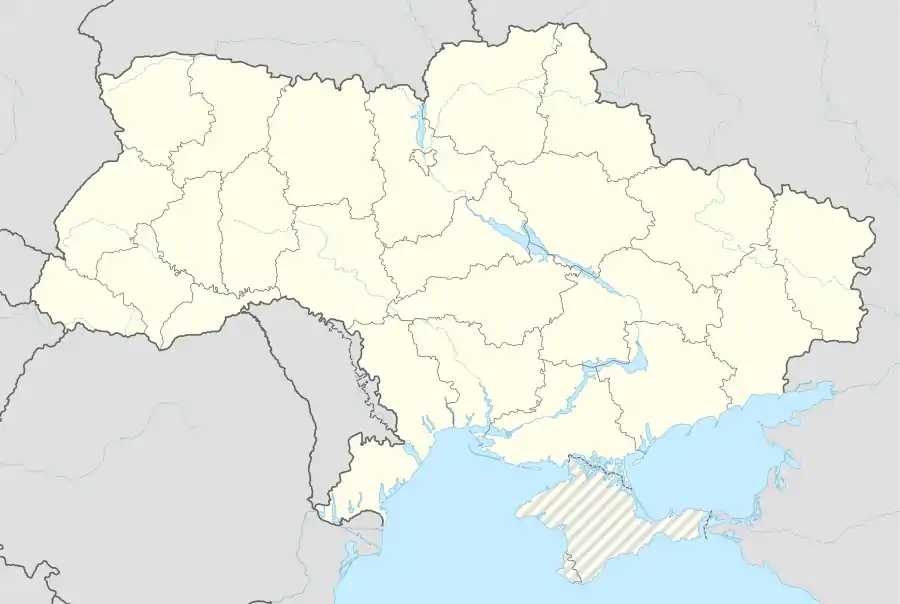 Mlyniv Mlyniv (Ukraine) | |
| Coordinates: 50°30′50″N 25°36′24″E | |
| Country | |
| Province | |
| District | Mlyniv Raion |
| First mentioned | 1445 |
| Town status | 1959 |
| Government | |
| • Town Head | Serhiy Vorobei |
| Area | |
| • Total | 20.52 km2 (7.92 sq mi) |
| Elevation | 191 m (627 ft) |
| Population (2001) | |
| • Total | 8,446 |
| • Density | 410/km2 (1,100/sq mi) |
| Time zone | UTC+2 (EET) |
| • Summer (DST) | UTC+3 (EEST) |
| Postal code | 35100 |
| Area code | +380 3659 |
| Website | http://rada.gov.ua/ |
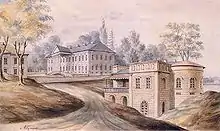
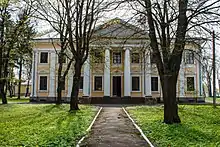
The settlement is located on the banks of the Ikva River, a tributary of the Styr.[2] It acquired the status of an urban-type settlement in 1959 in Soviet Ukraine.
History
The settlement has a long history. Archaeological excavations confirm that its territory was populated at least since the I BCE.[4] At its northern outskirts at right bank of Ikva were discovered traces of flint tool shop and remnants of old-Ruthenian settlement of Muravytsia that was mentioned in chronicles of 1149.[4]
Mlyniv itself was first mentioned when Grand Duke Alexander Jagiellon gave it away to someone by the name of Bobr sometime in beginning of 16th century.[4] In 1508 it became a private property of Kremenets governor Montaut.[4] Due to ownership of the settlement was changing often, it suffered greatly due to increase of exploitation and implementation of higher taxes and dues.[4] In 1566 there was formed Volhynian Voivodeship, Grand Duchy of Lithuania and the settlement became a part of it. In 1568 Prince Holovnia-Ostrzozecki attacked and robbed the village.[4] After the 1569 Union of Lublin, the Volhynian Voivodeship became part of the Crown of Poland. By the 17th century population of the settlement was no higher than 300 people.[4]
During the Khmelnytskyi Uprising, the settlement supported rebelled Cossacks.[4] In spring of 1648 the insurgents destroyed the neighboring mansion of Muravytsia.[4] The struggle against the Crown of Poland did not stop with signing of the Muscovite–Polish treaty of Andrusovo.[4] At the times of the ruin, in Mlyniv lived Ukrainian poet and important public figure Danylo Bratkovsky who supported the armed uprising of Semen Paliy (see Paliy uprising)[4] who sought unification of all Ukraine on both banks of Dnieper. Bratkovsky wrote an official statement to people with a call to stand against the efforts of Jesuits and Uniates (Ruthenian Uniate Church).[4]
After extinguishing peasant revolts, the new owner of the settlement Prince Chodkiewicz built a new palace and kosciol (Roman Catholic temple).[4] In Soviet, Russian and later Ukrainian historiography, a term of kosciol is used to underline a policy of Polonization and Catholization.
It was granted Magdeburg rights by the Polish king in 1789, before the Second Partition of Poland. In 1792 the settlement was visited by Polish national hero Tadeusz Kościuszko.[4] Following the partition of Poland, in 1795 Mlyniv was included at first to the Volhynian Viceroyalty and in two years to Dubno county of Podolia Governorate.[4] Since 1804 it was included into the Volhynian Governorate,[4] Russian Empire.
Russian period
In 1840s Mlyniv was visited by Polish writer-ethnographer Józef Ignacy Kraszewski who described Mlyniv (Młynów) and mentioned Chodkiewicz Palace in his work "Recollections from Volhynia, Polesie, and Lithuania".[4]
After the 1861 Russian agrarian reform the local peasants had to pay "chynsh", 8 poods of grain from one morgue (.56 hectares (1.4 acres)).[4] Since 1860s in Mlyniv existed a sawmill, a small wine distillery, a simple iron-casing shop which accounted for some of 60 workers in 1903-04.[4] Fishing in local rivers for local population was prohibited.[4] There were couple of big fires in 1858 and 1905 which destroyed some 60 buildings.[4]
During the 1905 Revolution, the iron casting shop fell under influence of the Konotop organization of Russian Social Democratic Labour Party.[4] In summer of 1906 strikes and demonstrations in Mlyniv involved some 200 workers and caused local authorities help from Dubno county authorities.[4] The revolutionary activities ceased by December 1906, after from Dubno was dispatched a police cavalry detachment.[4] In Mlyniv existed a small two-grade parish school, which in 1911 graduated 9 boys and three girls.[4]
During the World War I many buildings in the settlement were destroyed.[4] In 1915 Mlyniv was located right at the Austrian-Russian frontline (Eastern Front).[4] The Chodkiewicz Palace and park were in hands of Austrian troops, while the settlement was held by Russian.[4]
Soon after the Bolshevik coup-d'état (also known as October Revolution), in Mlyniv was created a volost committee headed by Zabolotsky. The committee nationalized Chodkiewicz Palace.[4] In February 1918, Mlyniv was liberated from the Soviet authorities with help of Austro-German troops.[4] Mlyniv became part of the Ukrainian People's Republic. In June 1919 the First Ukrainian Soviet Division destroyed Ukrainian troops and reinstated the Soviet regime in Mlyniv.[4] After that Mlyniv was governed by local kombed.[4]
Polish period
During the Polish–Soviet War, Mlyniv was changing hands between various armies.[4] In July 1920 for short period of time the Soviet regime once again was secured on the efforts of the 14th Soviet Cavalry Division (commander Oleksandr Parkhomenko, part of the First Cavalry Army, Konnarmia).[4] By the 1921 treaty of Riga, Mlyniv became part of the Second Polish Republic (Wołyń Voivodeship).[4]
In 1921 Mlyniv was accounted for some 1263 people.[4] As part of Poland, in Mlyniv Polish language became enforced (revived) as the official.[4] In 1932 there was built a state seven-grade school.[4] There also was opened a local pharmacy.[4] In 1930 population of Mlyniv declined in comparison with 1921.[4] In February 1926 in Mlyniv was created a local committee of Communist Party of Western Ukraine and since 1935 its youth wing Komsomol.[4] To fight increase of communist influence a local starosta requested to increase number of local police force.[4] In September 1934 some demonstrations organized by local communists resulted in arrest of 23 people.[4] Another communist actions took place in February 1938 in relations to free Belarusian revolutionary Siarhei Prytytski.[4] The action called to help Republican Spain (Spanish Civil War), fight fascism, democratization of Poland and liberation of West Ukraine.[4] In Mlyniv existed Catholic parish within Dubno county.
World War II and anti-Polish atrocities
Soon after the start of World War II and next partition of Poland by Nazi Germany and Soviet Union the village as part of West Ukraine became again occupied (liberated) by the Red Army.[4][5] Near Mlyniv was stationed for two years the 8th Mechanized Corps (commander Dmitry Ryabyshev).[4] A number of prominent Polish families were sent to Siberia by the NKVD in 1940.[5][6] In October 1939 in Mlyniv took place elections to the National Assembly of Western Ukraine.[4] Following admission of Western Ukraine to the Soviet Union and unification with the Ukrainian SSR, Mlyniv became an administrative center of Mlyniv Raion.[4] In Mlyniv was opened local club, library, maternity hospital, and small clinic.[4]
Mlyniv was overrun by the German army in Operation Barbarossa on 24 June 1941.[4] The local school was transformed into headquarters of commandant and Gestapo.[4] During the Nazi Germany occupation there were killed 1118 people.[4] In repressions against local Soviet population participated Ukrainian nationalists.[4] In June 1943 local population provided some assistance for the Sydir Kovpak partisans.[4]
Between 1942 and 1945 it was one of many sites of massacres of Poles and Jews committed by the death squads of Ukrainian Insurgent Army and the local Ukrainian peasants.[7]
Notably, the Ukrainian sotnia led by Hryrory Levko ("Kruk") operated in the area until 1947,[8] long after the Soviet counter-offensive of 1944.[7] The Polish self-defence in Młynów managed to hold back the repeated raids by the Ukrainian nationalists as one of only several such outpost, which also included the civilian defence of Kurdybań Warkowicki, Lubomirka, Klewań, Rokitno, Budki Snowidowickie, and Osty. Their survival could be at least partly explained by the Nazi German presence there before the Soviet takeover.
During the Polish population transfers (1944–46) the remaining Polish inhabitants of Mlyniv have been expelled.[7]
Post war
.jpg.webp)
Mlyniv was liberated from occupation of Nazi Germany by the Soviet 13th Guard Cavalry Division (commander Pyotr Zubov).[4] Following the war, population of Mlyniv accounted for 462 people.[4]
Since May 1953 in Mlyniv operates Mlyniv Hydro-Electric Station with single turbine of Austrian company Voith.[9] Construction of the HES has started during the Second Polish Republic.[9] During that time there was built a dam.[9] Due to the war, the further construction was suspended.[9]
References
- "Mlyniv (Rivne Oblast, Mlyniv Raion)". weather.in.ua. Retrieved 9 February 2012.
- "Mlyniv, Rivne Oblast, Mlyniv Raion". Regions of Ukraine and their Structure (in Ukrainian). Verkhovna Rada of Ukraine. Retrieved 9 February 2012.
- "Чисельність наявного населення України (Actual population of Ukraine)" (PDF) (in Ukrainian). State Statistics Service of Ukraine. Retrieved 30 September 2020.
- Bukhalo, H., Vovk, A. Mlyniv, Mlyniv Raion, Rivne Oblast (Млинів, Млинівський район, Ровенська область). The History of Cities and Villages of the Ukrainian SSR.
- Strony o Wołyniu (August 2006). "Miasteczko, wieś Młynów, gmina Młynów, powiat Dubno, woj. wołyńskie". Wolyn.ovh.org. Including location map and names of prominent individuals. Archived from the original on 2017-01-03. Retrieved 2017-01-03.
- Списки жертв (2016). "Ровенская обл., Млынов". Польские спецпереселенцы в Архангельской обл. Lists.memo.ru.
- Zarys ogólny wydarzeń. Ludobójstwo dokonane przez nacjonalistów ukraińskich na ludności polskiej Wołynia 1939-1945 by Władysław Siemaszko and Ewa Siemaszko. 9 November 2007. Placówki i ośrodki (bazy) samoobrony (excerpts). Archived from the original on 9 November 2007 – via Internet Archive.CS1 maint: bot: original URL status unknown (link)
- Grzegorz Rąkowski (2006). Polska egzotyczna, Part 2. Oficyna Wydawnicza "Rewasz". p. 371. ISBN 8389188562.
- In Mlyniv receive electrical power right from water (У Млинові отримують електроенергію прямо з води). Newspaper "Volyn". 27 July 2018
External links
| Wikimedia Commons has media related to Mlyniv. |
